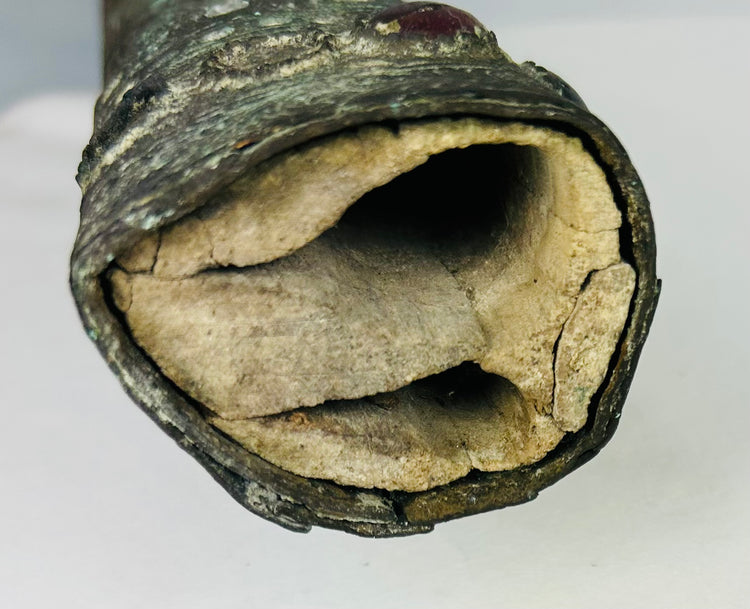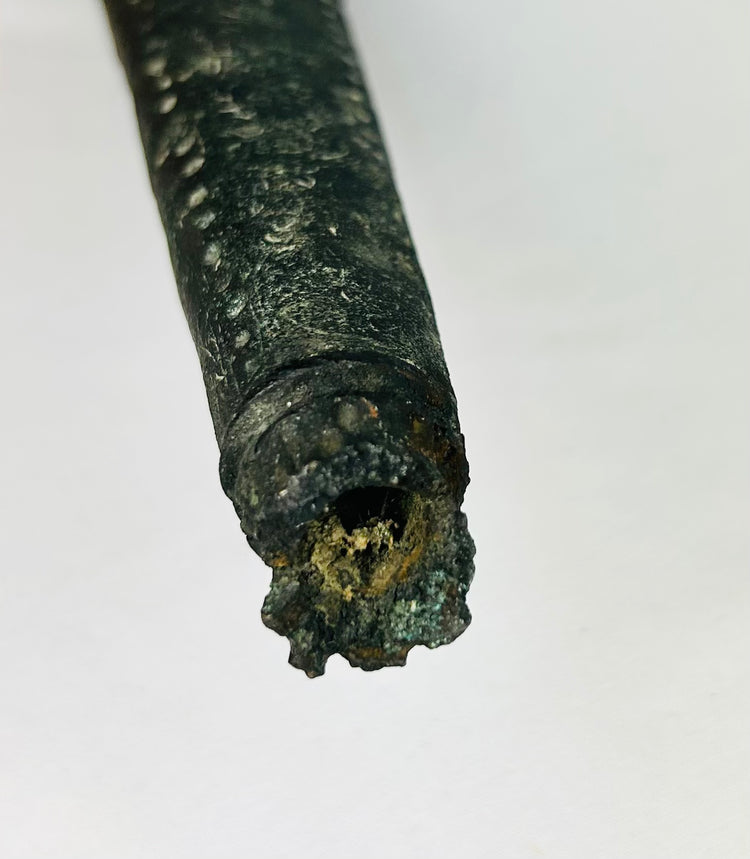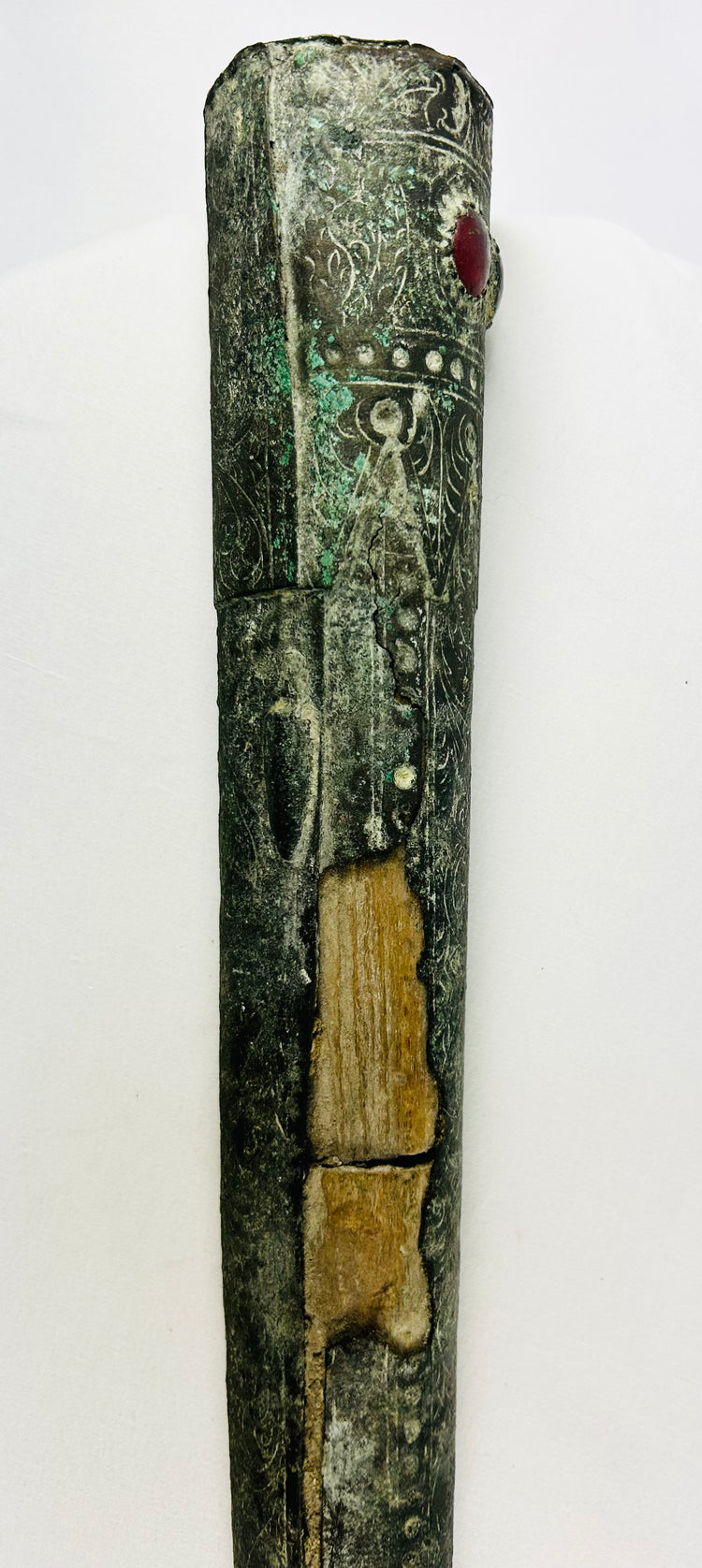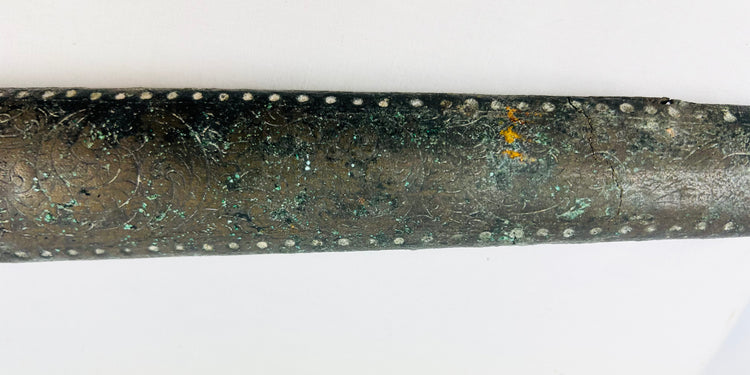Fourreau d'épée étrusque antique en bronze | Artefact de guerrier de haut rang | 900–700 av. J.-C.
Description
Plus
Moins
Contexte historique et origine
Région : Étrurie (aujourd'hui Toscane et Latium, Italie)
Matériau : Bronze avec incrustation de pierres précieuses
Période : 900–700 av. J.-C.
Description
Ce magnifique fourreau d'épée en bronze est un exemple rare et important de l'artisanat étrusque primitif. Mesurant environ 45 cm de long, il est décoré de lignes gravées complexes, d'ornements poinçonnés et de pierres précieuses incrustées dans des tons rouges et foncés, reflétant à la fois prestige et art. La finesse des détails et son caractère cérémoniel suggèrent qu'il a été créé pour un noble ou un guerrier de haut rang, incarnant à la fois puissance martiale et statut aristocratique. Une riche patine verte, acquise au fil des siècles, renforce encore son authenticité et sa présence visuelle.
Caractéristiques
- Décor élaboré gravé et poinçonné
- Incrustations de pierres précieuses dans des tons rouges et foncés, symbolisant la richesse et le pouvoir
- Bronze forgé à la main avec un savoir-faire exceptionnel
- Riche patine témoignant d'une grande antiquité
Importance culturelle
Les Étrusques, prospères entre le IXe et le VIe siècle avant J.-C., étaient réputés pour leur métallurgie avancée et leur art sophistiqué, qui ont grandement influencé la culture romaine. Les fourreaux décoratifs en bronze comme celui-ci n'étaient pas seulement fonctionnels, mais constituaient aussi des symboles de statut social pour les guerriers d'élite, souvent utilisés lors de cérémonies ou pour des commandes prestigieuses. Ce fourreau illustre le raffinement des traditions martiales étrusques et l'importance culturelle accordée à l'armement, à la fois comme outil de guerre et comme symbole d'identité.
Condition
Remarquablement bien conservé, avec sa patine d'origine et ses incrustations de pierres apparentes. L'usure superficielle due à son âge élevé renforce son authenticité.
Dimensions (approximatives)
Longueur : 18 po
Âge
900–700 av. J.-C.
Description
Contexte historique et origine
Région : Étrurie (aujourd'hui Toscane et Latium, Italie)
Matériau : Bronze avec incrustation de pierres précieuses
Période : 900–700 av. J.-C.
Description
Ce magnifique fourreau d'épée en bronze est un exemple rare et important de l'artisanat étrusque primitif. Mesurant environ 45 cm de long, il est décoré de lignes gravées complexes, d'ornements poinçonnés et de pierres précieuses incrustées dans des tons rouges et foncés, reflétant à la fois prestige et art. La finesse des détails et son caractère cérémoniel suggèrent qu'il a été créé pour un noble ou un guerrier de haut rang, incarnant à la fois puissance martiale et statut aristocratique. Une riche patine verte, acquise au fil des siècles, renforce encore son authenticité et sa présence visuelle.
Caractéristiques
- Décor élaboré gravé et poinçonné
- Incrustations de pierres précieuses dans des tons rouges et foncés, symbolisant la richesse et le pouvoir
- Bronze forgé à la main avec un savoir-faire exceptionnel
- Riche patine témoignant d'une grande antiquité
Importance culturelle
Les Étrusques, prospères entre le IXe et le VIe siècle avant J.-C., étaient réputés pour leur métallurgie avancée et leur art sophistiqué, qui ont grandement influencé la culture romaine. Les fourreaux décoratifs en bronze comme celui-ci n'étaient pas seulement fonctionnels, mais constituaient aussi des symboles de statut social pour les guerriers d'élite, souvent utilisés lors de cérémonies ou pour des commandes prestigieuses. Ce fourreau illustre le raffinement des traditions martiales étrusques et l'importance culturelle accordée à l'armement, à la fois comme outil de guerre et comme symbole d'identité.
Condition
Remarquablement bien conservé, avec sa patine d'origine et ses incrustations de pierres apparentes. L'usure superficielle due à son âge élevé renforce son authenticité.
Dimensions (approximatives)
Longueur : 18 po
Âge
900–700 av. J.-C.
Vous aimerez peut-être aussi
































